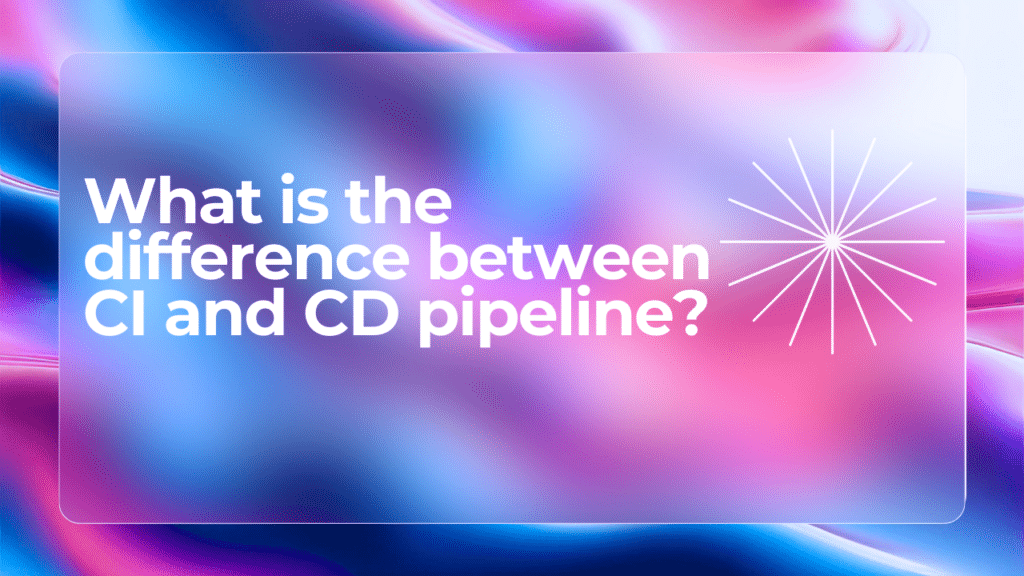Key Takeaways:
- CI/CD pipelines and DevOps practices are essential for modern software development.
- CI/CD automates code delivery, ensuring speed, efficiency, and quality.
- DevOps fosters collaboration, breaking down silos for seamless workflows.
- Integration of CI/CD pipelines enhances productivity and customer satisfaction.
- Challenges include cultural shifts, technical complexities, and security concerns.
- Best practices include communication, automation, security prioritization, monitoring, and continuous learning.
- Successful integration leads to faster delivery cycles and consistent deployability.
- Understanding DevOps philosophy drives innovation, agility, and efficiency in development processes.
Question: What are CI/CD pipelines and DevOps practices?
Answer: CI/CD pipelines automate code delivery, ensuring speed, efficiency, and quality in software development. DevOps fosters collaboration, breaking down silos for seamless workflows. Integrating CI/CD enhances productivity and customer satisfaction, despite challenges like cultural shifts and technical complexities. Best practices include communication, automation, security prioritization, monitoring, and continuous learning. Successful integration leads to faster delivery cycles and consistent deployability, driving innovation, agility, and efficiency in development processes.
Introduction to CI/CD Pipelines and DevOps
Welcome to the dynamic world of software development where speed, efficiency, and quality are paramount. In this fast-paced digital age, staying ahead requires embracing innovative strategies like CI/CD pipelines and DevOps practices. Are you ready to dive into the realm where automation meets collaboration? Let's explore how CI/CD pipelines play a crucial role in the larger framework of DevOps philosophy!
Defining CI CD Pipelines
CI/CD pipelines are at the core of modern software development practices. But what exactly do we mean when we talk about them? In simple terms, a CI CD pipelines automates the process of delivering code changes from version control to production.
The "CI" stands for Continuous Integration, which involves automatically testing and integrating code changes as they are committed by developers. On the other hand, "CD" encompasses both Continuous Delivery and Continuous Deployment. While Continuous Delivery ensures that your code is always in a deployable state, Continuous Deployment takes it a step further by automatically releasing every change to production.
By setting up a CI/CD pipeline, teams can streamline their development workflows, catch bugs early on, and deliver value to customers more quickly and efficiently. It's all about building quality into the software delivery process right from the start.

Understanding the DevOps Philosophy
The DevOps philosophy emphasizes collaboration and communication between development and operations teams. It aims to break down silos, fostering a culture of shared responsibility for the entire software delivery process.
By promoting automation, DevOps seeks to streamline workflows, increase efficiency, and reduce manual errors. Continuous integration (CI) and continuous deployment (CD) play crucial roles in achieving these goals by automating the building, testing, and deployment processes.
DevOps also values feedback loops that allow for quick iterations based on real-world usage data. This iterative approach enables teams to respond promptly to changes and deliver value to customers faster.
Understanding the DevOps philosophy is not just about implementing tools or technologies; it's about embracing a mindset shift towards collaboration, automation, feedback-driven improvement, and continuous delivery.
The Relationship Between CI CD Pipelines and DevOps
CI/CD pipelines and DevOps go hand in hand, like two peas in a pod. Picture CI/CD as the efficient conveyor belt that transports your code changes seamlessly across different stages of development. Now imagine DevOps as the master orchestrator conducting a symphony, ensuring collaboration between teams and automating processes.
In this dynamic duo, CI/CD pipelines act as the enabler for implementing DevOps practices successfully. They provide the necessary automation and continuous feedback loops essential for achieving faster delivery cycles without compromising quality. By integrating CI/CD pipelines within a DevOps environment, organizations can streamline their software development lifecycle and foster a culture of continuous improvement.
The synergy between CI/CD pipelines and DevOps is not just about technology; it's about fostering a mindset shift towards agility, collaboration, and innovation. When these elements harmonize effectively, businesses can achieve greater efficiency, reduced time to market, and enhanced customer satisfaction.
Benefits of Implementing CI/CD Pipelines in a DevOps Environment
Implementing CI/CD pipelines in a DevOps environment brings numerous benefits to organizations looking to streamline their software development processes. It allows for faster delivery of code changes, enabling teams to release updates more frequently and efficiently. This results in quicker feedback loops and improved collaboration among different teams involved in the development process.
Moreover, CI/CD pipelines help automate repetitive tasks such as testing and deployment, reducing the likelihood of human error and increasing overall reliability. By automating these processes, developers can focus on writing quality code rather than manual labor.
Additionally, implementing CI/CD pipelines promotes a culture of continuous improvement within an organization. It encourages teams to adopt agile practices and embrace change regularly. This adaptability is crucial in today's fast-paced tech landscape where innovation is key to staying ahead of the competition.
Integrating CI/CD pipelines into a DevOps environment leads to increased productivity, higher quality software releases, and ultimately better customer satisfaction.
Challenges of Incorporating CI/CD Pipelines in DevOps
Implementing CI/CD pipelines in a DevOps environment comes with its set of challenges. One common challenge is the cultural shift required within organizations to embrace automation and collaboration across teams. Resistance to change and lack of buy-in from stakeholders can hinder the successful integration of CI/CD pipelines.
Technical challenges also arise, such as ensuring consistent environments for development, testing, and deployment stages. Compatibility issues between different tools and technologies used in the pipeline can lead to integration complexities that need to be carefully addressed.
Security concerns around automated processes and continuous delivery of code pose another challenge. Maintaining secure access controls, encryption standards, and vulnerability management throughout the pipeline is crucial but can be demanding.
Moreover, scaling CI/CD pipelines as projects grow in complexity requires careful planning and resource allocation. Ensuring efficient monitoring, logging, and troubleshooting mechanisms are in place becomes essential to mitigate potential bottlenecks or failures during the pipeline execution process.

Best Practices for Successful Integration of CI/CD Pipelines in DevOps
When it comes to successfully integrating CI/CD pipelines in a DevOps environment, there are several best practices to keep in mind. Establish clear communication channels between development and operations teams to ensure seamless collaboration throughout the pipeline process.
Automate as much as possible to increase efficiency and reduce the risk of human error. This includes automating testing, deployment, and monitoring processes.
Prioritize security by implementing proper access controls and regularly scanning for vulnerabilities in your codebase.
Fourthly, continuously monitor and measure performance metrics to identify bottlenecks or areas for improvement within your pipeline.
Foster a culture of continuous learning and improvement within your team members to adapt to new technologies and methodologies effectively. By following these best practices, you can optimize your CI/CD pipeline integration within a DevOps framework effectively.
Conclusion
CI/CD pipelines are a crucial component of DevOps practices. By automating the build, test, and deployment processes, organizations can achieve faster delivery cycles with improved quality and reliability. The integration of CI/CD pipelines in Azure DevOps provides a seamless solution for teams looking to streamline their development workflows and accelerate software delivery.
Embracing this continuous integration and continuous delivery approach not only enhances team collaboration but also ensures that applications are consistently deployable at any given point in time. Despite the challenges that may arise during the implementation phase, following best practices and leveraging the right tools can lead to the successful integration of CI/CD pipelines within a DevOps environment.
By understanding the philosophy behind DevOps and recognizing the benefits of CI/CD pipelines, organizations can foster a culture of innovation, agility, and efficiency in their software development processes. Continuous improvement is at the core of both DevOps principles and CI/CD pipeline methodologies – enabling teams to adapt quickly to changing requirements while delivering value to customers more effectively.
FAQs about CI CD Pipelines and DevOps
- How do CI/CD pipelines enhance collaboration within DevOps teams? CI/CD pipelines foster collaboration by automating manual tasks, facilitating continuous feedback, and promoting shared ownership of code quality and delivery.
- What are some common tools used for implementing CI/CD pipelines in DevOps environments? Popular CI/CD tools include Jenkins, GitLab CI, Travis CI, CircleCI, and GitHub Actions, each offering unique features and integrations to streamline the development process.
- Can CI/CD pipelines be applied to both monolithic and microservices architectures? Yes, CI/CD pipelines are architecture-agnostic and can be tailored to suit the specific needs and complexities of both monolithic and microservices-based applications.
- How does CI/CD contribute to the resilience and reliability of software systems? By automating testing and deployment processes, CI/CD pipelines help identify and mitigate errors early in the development cycle, thereby enhancing the resilience and reliability of software systems in production.
- What role does automation play in CI/CD pipelines, and how does it align with DevOps principles? Automation is central to CI/CD pipelines, enabling the rapid, repeatable, and reliable delivery of software updates. This aligns with DevOps principles of automation, collaboration, and continuous improvement.
- How can organizations measure the effectiveness of their CI/CD practices within a DevOps framework? Key metrics for evaluating CI/CD effectiveness include deployment frequency, lead time for changes, mean time to recover, and change failure rate, providing insights into the efficiency and maturity of DevOps processes.
Comments (0)